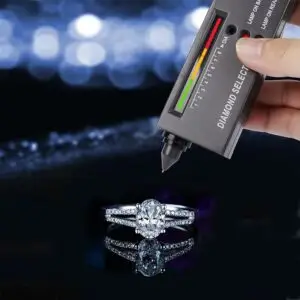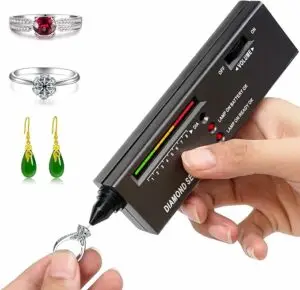Harnessing the Power of Diamond Testers in Precious Metals Scrap Dealing
In the competitive and intricate world of precious metals scrap dealing, tools that enhance efficiency and profitability are invaluable. One such tool, often overlooked for its simplicity and low cost, is the diamond tester. Retailing for under $20, this basic device is not just for jewelers but is a crucial asset for scrap metal dealers, especially those dealing in gold, silver, and platinum.
Identifying Valuable Gems in Scrap
For scrap dealers, the primary business involves buying scrap materials, melting them down, and extracting valuable metals for assay and refining. However, amidst these metals often lie hidden treasures

—diamonds and other precious stones that are unintentionally overlooked. Herein lies the utility of a diamond tester, which uses thermal conductivity to identify diamonds accurately.
By integrating a diamond tester into their evaluation process, dealers can effectively distinguish diamonds from other less valuable stones or imitations. This capability is crucial because it prevents the potential loss of valuable gemstones during the melting process, where everything is reduced to a homogenous mass.
Economic Benefits of Using a Diamond Tester
The economic argument for using a diamond tester is compelling. Firstly, by identifying and extracting diamonds from the scrap before melting, dealers can prevent the loss of these valuable stones, which could be sold separately for a significant profit. This not only boosts the revenue from scrap dealing operations but also diversifies income sources, making the business more resilient to fluctuations in metal prices.
Secondly, the ability to offer a more comprehensive recycling service—recovering both metals and gemstones—enhances the dealer’s market position. It allows them to offer competitive prices for scrap, attracting more sellers who are reassured that their precious stones will not be wasted. This reputation for meticulousness and thoroughness can distinguish a dealer from competitors.
Practical Implementation
Implementing the use of a diamond tester is straightforward. Dealers

need to train their staff to use the tester as part of the initial appraisal process. When scrap is brought in, each piece should be examined for gemstones. Any identified diamonds can then be carefully removed before the rest of the material is processed for metal recovery. This approach ensures that all potential value is extracted from the scrap, maximizing profitability.
Enhancing Customer Trust
Beyond the direct financial gains, using a diamond tester also helps in building trust with clients. Sellers of scrap are more likely to return if they believe that their materials will be thoroughly sorted and valued fairly. Transparent practices, like using a diamond tester, demonstrate a commitment to fairness and integrity, fostering long-term relationships with clients.
Conclusion
For precious metals scrap dealers, a diamond tester is not just a tool but an essential investment that pays for itself many times over. Its low cost is dwarfed by the potential gains from recovered diamonds and the enhanced reputation it brings. In a business where every small edge counts, a diamond tester is a wise and profitable addition to any dealer’s toolkit, ensuring that no stone—literally—is left unturned.
Note :
There are more proftional testers which cost more but also good to have ,such as the:
Presidium Instruments Gem Tester II


How the Daimond teater works:
Diamond testers work by measuring the thermal conductivity of a material to determine whether it is a genuine diamond. Diamonds have a unique ability to conduct heat efficiently, more so than most other gemstones. This characteristic is due to the strong covalent bonding between carbon atoms in a diamond’s crystal lattice, which allows heat to dissipate quickly through the structure.
A diamond tester features a small, probe-like tip that is applied to the gemstone. When the tip touches the stone, the device sends a small amount of heat into the stone and then measures the rate at which the heat moves away from the probe. If the heat disperses quickly, indicative of high thermal conductivity, the device signals that the stone is likely a diamond. If the heat disperses slowly, it indicates lower thermal conductivity, suggesting that the stone is not a diamond but perhaps a different gemstone or a synthetic substitute with similar appearance but different physical properties.


